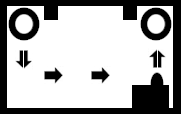|
 For
aquariums that lack the space below the main display, there are
several options. First, a separate tank can be placed beside,
behind or above the main display tank and plumbed with an overflow
box and/or bulkheads. This style can present some challenges, but
allows for the most visibility and enjoyment of the refugium.
Another option is a small hang-on-the-back refugium as illustrated
to the right. These smaller versions can be added to systems that
lack the appropriate space under the aquarium. These most
often include a small circulation pump that draws aquarium water
from one end of an acrylic box and out the other end. Although
small in size, they can be effective in smaller aquariums up to 30
gallons. For
aquariums that lack the space below the main display, there are
several options. First, a separate tank can be placed beside,
behind or above the main display tank and plumbed with an overflow
box and/or bulkheads. This style can present some challenges, but
allows for the most visibility and enjoyment of the refugium.
Another option is a small hang-on-the-back refugium as illustrated
to the right. These smaller versions can be added to systems that
lack the appropriate space under the aquarium. These most
often include a small circulation pump that draws aquarium water
from one end of an acrylic box and out the other end. Although
small in size, they can be effective in smaller aquariums up to 30
gallons.
Flow
rates can vary greatly in these systems, but most favor a high
turnover ratio, as much as 10x the water volume per hour. Larger
display tanks featuring corals and invertebrates can benefit from
even higher flow rates. In their natural environment, most marine
flora and fauna live in a dynamic place, with strong currents and
constantly changing tidal surge, so they are quite accustomed to
adapt to varied levels of water movement.
Light
fixtures for refugiums are readily available and many are actually
built into the design of the lid. Led lighting is by far the most popular
choice but it should be full spectrum as actinic and blue light
doesn't provide a useful wavelength for most algae species. Some
have had success with both red and yellow light but this spectrum
tends to fuel the growth of undesirable micro algae as well.
|